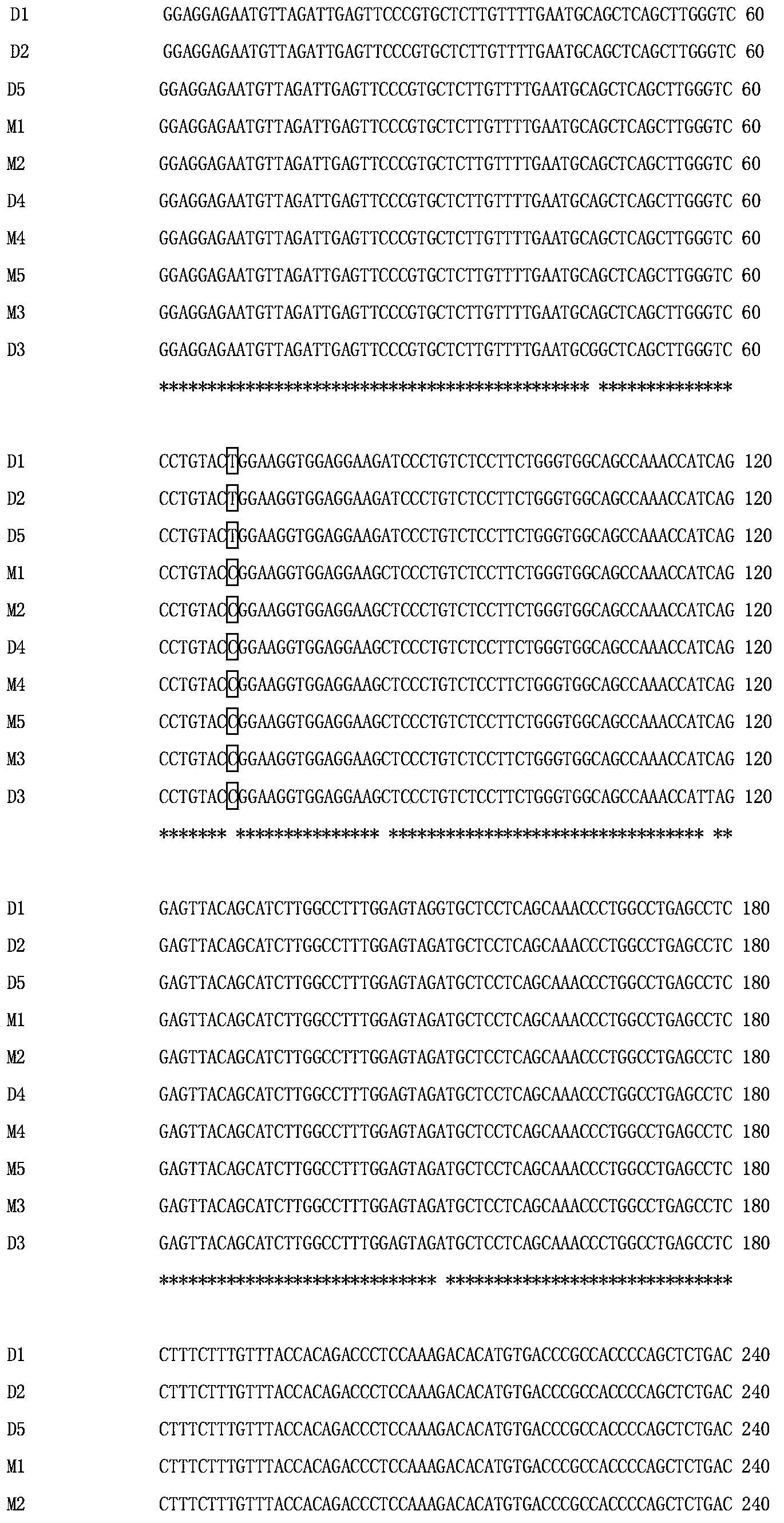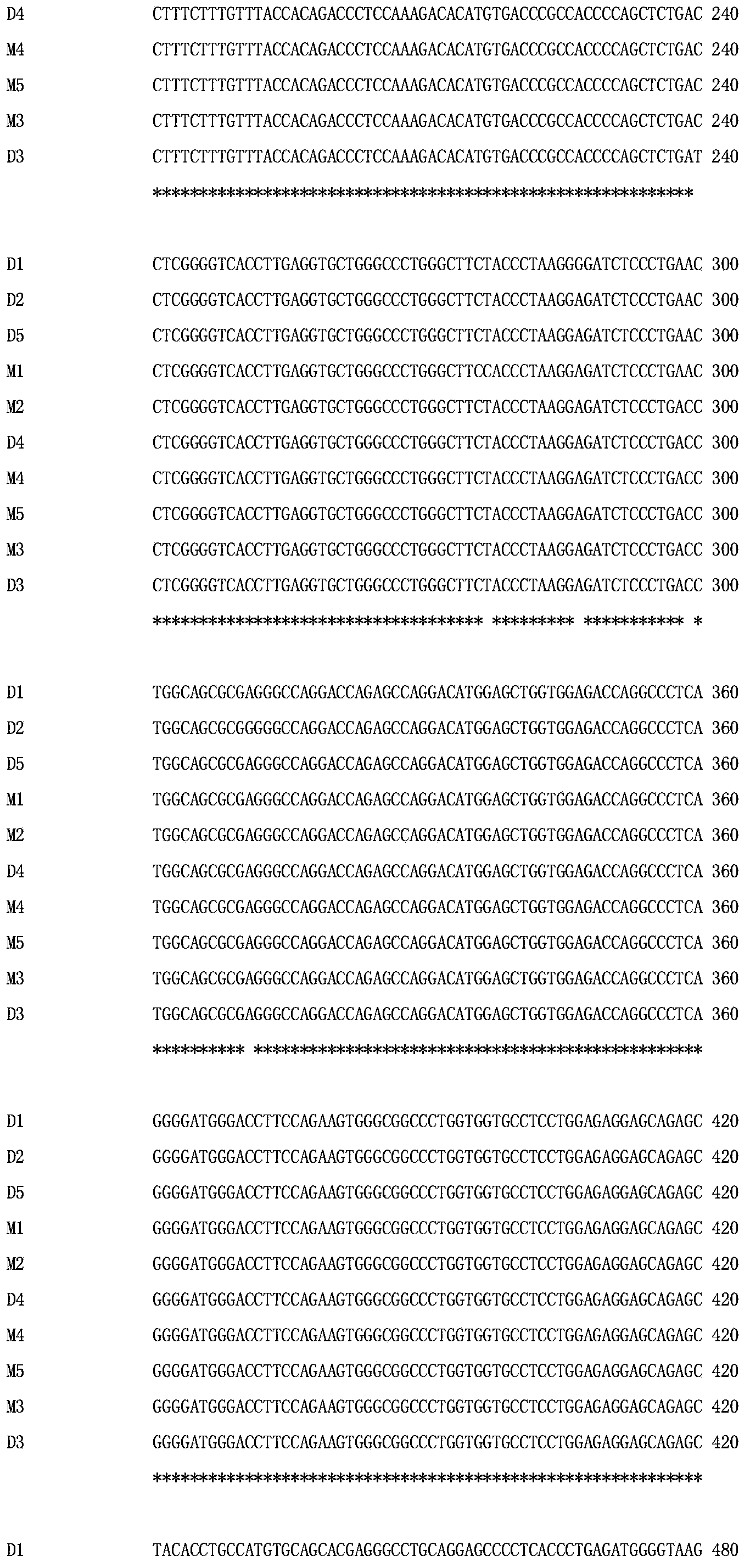Genetic marker for character of litter size of pig utilizing SLA-11 gene
A technology of genetic markers and litter size, applied in genetic engineering, plant gene improvement, recombinant DNA technology, etc., can solve the problems of slow progress in reproductive traits and low heritability of sows
- Summary
- Abstract
- Description
- Claims
- Application Information
AI Technical Summary
Problems solved by technology
Method used
Image
Examples
Embodiment 1
[0031] Example 1: Obtaining of swine SLA-11 gene fragments and establishment of polymorphism detection method
[0032]Log in to the Ensembl database (http: / / asia.ensembl.org / Sus_scrofa / Info / Index) to download the porcine SLA-11 gene sequence as the target sequence, and use the Primer5 software to design primers online. The primer sequences are shown in the sequence table as SEQ ID NO: 11 and Shown in SEQ ID NO: 12, details are as follows: SLA-2-PF: GGAGGAGAATGTTAGATTGAGTT, SLA-2-PR: AGGGCAGTGAAGTTAAGATAAGG. The amplified region includes the 1813bp genomic nucleotide sequence of the third intron of the porcine SLA-11 gene, as shown in SEQ ID NO:1. The PCR reaction system was 25 μl, in which the template DNA was 50 ng, the concentration of dNTPs was 200 μmol / L, the concentration of each primer was 0.4 μmol / L, 3 U of Taq DNA polymerase (Biostar International, Canada), and deionized water was added to a total volume of 25 μl ;PCR reaction program: pre-denaturation at 94°C for 4mi...
Embodiment 2
[0034] Example 2: Polymorphic distribution of genetic markers of the present invention in different pig herds
[0035] The method for extracting pig genome DNA (pig samples are shown in Table 1) is carried out with reference to Xiong Yuan's "Introduction to Pig Biochemistry and Molecular Genetic Experiments" China Agricultural Press, 1999 edition.
[0036] The PCR-MspI-RFLP polymorphism of the porcine SLA-11 gene was detected in 11 populations of pigs, and the detection results are shown in Table 1. The results showed that there were 3 genotypes in pig breeds such as Large White II (Nongke) and DIV. In all 11 populations tested, the allele frequency was 66.35%-100.00%, and the C allele was the dominant allele (see Table 1).
[0037] Table 1 Distribution results of pig SLA-11 gene PCR-MspI-RFLP in different pig breeds
[0038]
[0039]
[0040] Table 1 shows that the materials of the above populations are all breeds publicly promoted in China, among which: Large White P...
Embodiment 3
[0041] Example 3: Association analysis of genetic markers prepared by the present invention and litter size traits
[0042] In order to determine whether the pig SLA-11 gene PCR-MspI-RFLP is related to the difference in pig litter size, 117 new Chinese lean pig lines DIV line established by the Key Laboratory of Pig Genetics and Breeding of the Ministry of Agriculture of Huazhong Agricultural University and Hubei Academy of Agricultural Sciences were selected. The 264 Large White pig herds established by the Animal Husbandry and Veterinary Research Institute were used as test materials. The MspI-RFLP method established in Example 2 was used for polymorphism detection, and the correlation between different genotypes of pig MspI-RFLP and pig litter size traits was analyzed. The SAS statistical software (SAS Institute Inc, Version 8.0) GLM program was used for single-marker analysis of variance, and the REG program was used to calculate the additive effect and dominant effect of g...
PUM
 Login to View More
Login to View More Abstract
Description
Claims
Application Information
 Login to View More
Login to View More - R&D
- Intellectual Property
- Life Sciences
- Materials
- Tech Scout
- Unparalleled Data Quality
- Higher Quality Content
- 60% Fewer Hallucinations
Browse by: Latest US Patents, China's latest patents, Technical Efficacy Thesaurus, Application Domain, Technology Topic, Popular Technical Reports.
© 2025 PatSnap. All rights reserved.Legal|Privacy policy|Modern Slavery Act Transparency Statement|Sitemap|About US| Contact US: help@patsnap.com



